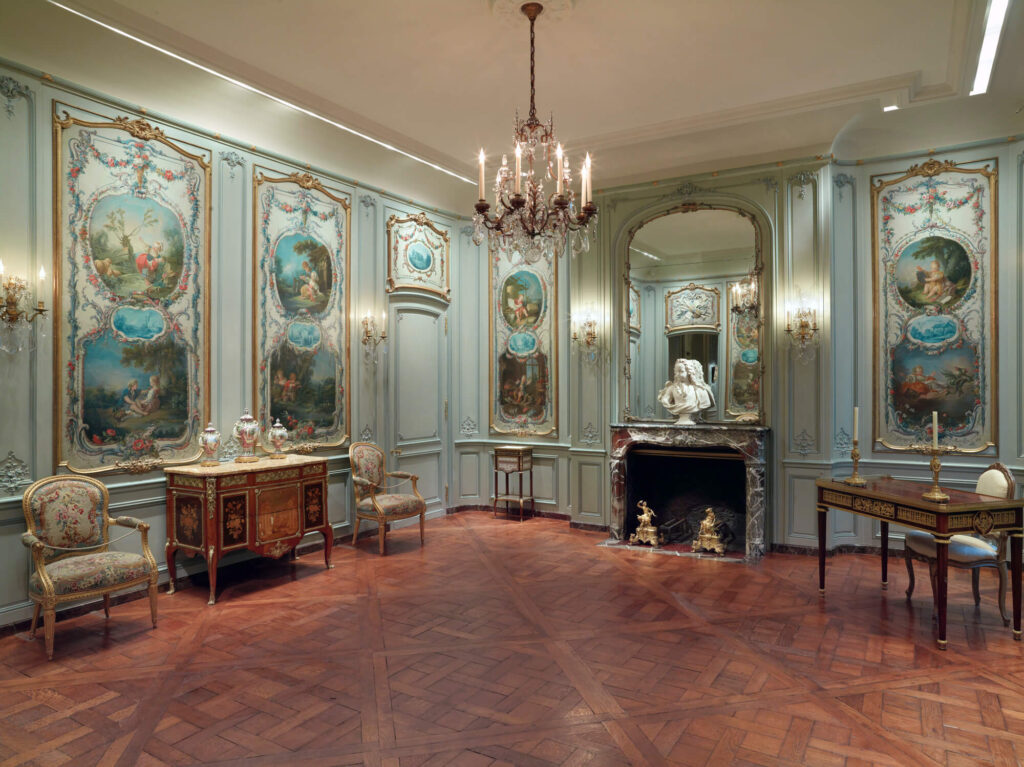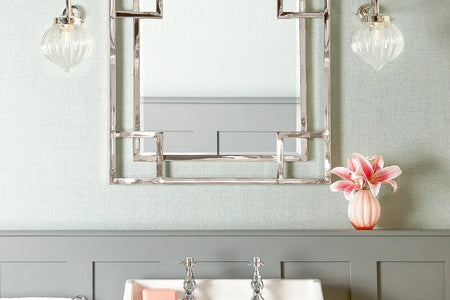
Revered as America’s first interior designer, Elsie de Wolfe’s client list included all the greats of the Golden Age of Hollywood. But ‘Lady Mendl’ was also a remarkable personality and a true pioneer - and not just in design. Here’s our guide to her life and times - plus some tips on bringing a hint of de Wolfe elegance into your own home...
Few interior designers have made a bigger impact on their world than Elsie de Wolfe (aka Lady Mendl). Widely regarded as America’s first interior designer, the native New Yorker was responsible for persuading her fellow Americans to turn their back on heavy, sombre interiors. For a room to earn de Wolfe’s seal of approval, it had to offer light, air and comfort, which goes a long way to explaining why, even though she was born in the middle of the 19th century, her approach still resonates strongly today. De Wolfe was a pioneer, not only in interior design but in the way she chose to live.When Elsie met Betty
Born in New York City in 1865, Elsie de Wolfe was the daughter of a Canadian doctor and his Aberdonian wife. Her childhood was spent in a typical New York brownstone, its gloomy interior full of dark furniture and furnishings - a look that Elsie loathed from her earliest years. As a young woman, she spent time in Scotland and London and was presented at court, although Queen Victoria did not, it would seem, impress her much… Back in her home city, the young New Yorker was initially drawn to the theatre and became a professional actress, which led to a meeting that was to change her life.
Elsie de Wolfe (right) with Bessie Marbury
Elisabeth Marbury, always known as Bessie, was a highly successful theatrical agent, representing leading actors and writers such a Sarah Bernhardt, George Bernard Shaw, Oscar Wilde and Georges Feydeau. Marbury would become de Wolfe’s lover, partner and mentor and, by 1887, the two women were sharing Bessie’s house in NYC. This was completely revamped by de Wolfe, who persuaded her partner to get rid of the cumbersome Victorian pieces, in favour of of 18th century neoclassical elegance, a softer, warmer colour palette, and a sense of space.
Before and after: Elsie de Wolfe decluttered the dining room of Bessie Marbury’s NYC house, replacing the Victorian clutter with a clean, neo-classical look
So successful was the transformation that it gave de Wolfe the confidence to embark, in 1905, on a different career as an interior designer. From 1905 word of her talent soon spread among New York’s most influential women, several of whom founded the Colony Club, and de Wolfe was commissioned to design the interiors. These were light and casual, with an abundance of glazed chint. The floors were tiled, the walls pale, and the chairs were made of wicker. And it was for the Colony Club that de Wolfe created the first of her signature trellis rooms.
Trellis Room, the Colony Club, NYC, designed by Elsie de Wolfe
The most significant commission in this period of de Wolfe’s career was for the Manhattan mansion of industrialist, art collector, and Francophile Henry Frick. De Wolfe was responsible for designing 14 of the mansion’s rooms for her Frick and his wife Adelaide, including the art gallery, Adelaide’s boudoir and a library for the couple’s daughter, Helen. De Wolfe had already made several extended visits to France and the interiors she designed for the family were a distinctly French combination of luxury and comfort. The mansion at 1 East 70th Street is now an art museum – the Frick Collection - but visitors can still see Mrs Frick’s original boudoir.
Mrs Frick’s boudoir, designed by Elsie de Wolfe
Life at the Villa Trianon
Despite the glamorous connections, de Wolfe had a strong social conscience. She was as a volunteer nurse during the First World War and, in recognition of her service in support of the Versailles Peace Treaty talks, France awarded her the Croix de Guerre. But when the war ended de Wolfe soon returned to interior design and alongside her ongoing professional association with Henry Frick she was independently building a very successful career and enjoying a lavish lifestyle.
On one of their frequent trips to Paris to seek out the latest fashions, she and Bessie Marbury had bought the Villa Trianon near Versailles, where de Wolfe succeeded in turning what had once been a wreck into a contemporary recreation of Louis XV style.
It was here that she would experiment with styles, textures, furniture and finishes, all of which were appreciated by a stream of visitors straight out of a 1930s Who’s Who. Regular guests included Cecil Beaton, Coco Chanel, Noel Coward, and the Duke and Duchess of Windsor and the villa provided the setting for some of the most glamorous and most memorable parties of the decade.
The sitting room at Villa Trianon
Hollywood’s favourite designer
With the outbreak of WII on the horizon, visits to Villa Trianon became impossible; the last party was held in 1939 and, by then, de Wolfe had already created an alternative transatlantic base in Beverly Hills. Here she would wait out the war and entertain existing and potential clients, becoming the interior designer of choice for many of Hollywood’s leading stars. By now, de Wolfe’s signature style had expanded to include Chinoiserie, which she combined with animal prints, English Regency and classic English furniture, such as Chippendale, as well as contemporary jazz-influenced black and white themes. She even embraced beige…
Marlene Dietrich in her Elsie de Wolfe-designed home, c1936.
For her own Beverly Hills home, which she named After All, de Wolfe’s preferred colour palette was more dramatic, mainly black, green and white; she opted for furnishings with a baroque influence, and placed mirrors in the gardens to heighten the sense of space.
The bar at After All, designed by Elsie de Wolfe
De Wolfe’s beloved Villa Trianon had been annexed by the Nazis during the war, after which it was occupied by the US High Command, who included General Eisenhower. By the time she was able to return in 1947, it was derelict and, for the next four years until she died, de Wolfe dedicated herself to its restoration.
Interior of Elsie De Wolfe' music pavilion looking out on to the pool , The Villa Trianon, painted by William Bruce Ellis Ranken
Lady Mendl’s life less ordinary
There are some twists in Elsie de Wolfe’s tale. In 1926, at the age of 61, she had married British diplomat and actor Sir Charles Mendl – much to the surprise of her friends, not least a deeply shocked Bessie Marbury.
It was, in every sense, a marriage of mutual convenience. The pair lived in separate apartments in Paris and Elsie paid her husband a monthly allowance. In return, she now had a title, which probably did no harm to her business or her social life and she enjoyed styling herself Lady Mendl. She is even namechecked in Cole Porter's classic song about modern scandals, Anything Goes:"When you hear that Lady Mendl, standing up/Now turns a handspring landing up-/On her toes/Anything goes!"
But, after a brief hiatus Elsie and Bessie were reconciled and they remained together until Bessie’s death in New York 1933. Despite being the main beneficiary of Marbury’s will, however, de Wolfe did not attend her long-term partner’s funeral. A lifelong fitness fanatic, de Wolfe practised yoga and exercised for an hour every morning.
She died at Versailles in 1950, aged 84, and her ashes were eventually interred in a common grave at Père Lachaise Cemetery. After her death, the Villa Trianon remained closed and in darkness for over 30 years, until its contents were auctioned in Paris in the 1980s. In 2015, Equality Forum would name Elsie de Wolfe as one of its icons for that year’s LGBT History Month. And in the same year, Marlene Dietrich’s former home in Beverly Hills sold for $23.5 million, the interiors more or less unchanged since de Wolfe had worked her 1930s design magic.
The mirrored dining room, Marlene Dietrich’s house, Beverly Hills
Pooky pays homage to Elsie de Wolfe
‘What would have caught Elsie’s eye?’ we asked ourselves, as we put together this mini-collection. There would have to be something stylish, pale and chic, with modern twist; something black and white in memory of the Beverly Hills days, and an animal print, perhaps, and definitely a touch of Chinoiserie. So our first choice is the Peardrop table lamp, as elegant as it gets – just watch the light dance through the cut crystal glass. It would certainly not have been out of place at one of Lady Mendl’s famous Villa Trianon parties. Crystal glass has a much higher ‘sparkle’ quotient than regular glass and is famous for its stunning clarity. Meanwhile, there is a definitely a hint of Hollywood about Matthew Williamson’s Classic Leopard Love shade, Peardrop
Peardrop
Sticking with the Hollywood look, Pooky’s Galore brass floor lamp, with its black base, gives you the option of a black shade or white. Either would have looked great in the bar at After All.
As we mentioned, Elsie de Wolfe loved mirrors, the more the better, indoors and outdoors. She was also partial to Chinoiserie, especially in her trellis rooms, so what better accessory than Pooky’s rectangular Baloo mirror? Baloo’s wood frame has been carved to resemble bamboo, and finished with a natural whitewash. Effortlessly stylish, light and elegant. Very Lady Mendl. Very Elsie de Wolfe.
If you enjoyed this post you'll also like these ones...
Great interior designers: Syrie Maugham
Classic Interior Design Styles and How to Light them: Art Deco











